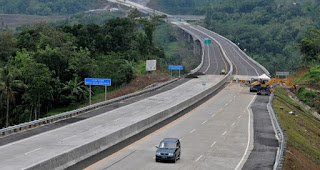Comprehensive Data on Road Infrastructure 2015-2019 was released in late April 2017 showing data, outlook, study, analysis, and research related to all information about road infrastructure in Indonesia. This comprehensive data captures the actual conditions, networks, quality, funding needs, backlogs, status and authority of road infrastructure in Indonesia for the period 2015-2019.
This comprehensive data starts from Indonesia’s economic outlook for 2017 (page 2-3), the trend of economic growth outlook for Indonesia in the quarter of 2014-2017 period (page 4), and economic value added value per region (page 5). On page 6-7, Indonesia’s infrastructure budget allocation per sector, from road infrastructure, rail, sea, air, land, urban transportation, electricity infrastructure, oil and gas infrastructure, telecommunication, water storage and housing, authorized agency.
Admission to the special discussion shows the condition of road infrastructure in Indonesia, ranging from the percentage of road transport, the length of the national road network, and road support in national connectivity (page 8). Continued on page 9, describing the quality of the road and its impact on the national competitiveness rating (page 9).
On page 10, the road infrastructure investment requirement from the strategic plan to the backlog is displayed from 2015 to 2019. Continue to page 11, elaborated on the length of the national road network, provincial roads, district roads, complete with road stability status, and authorized agencies.
The road investment requirement for the 2012-2017 period is explained in detail on page 12. Connecting priority road infrastructure development from 35 strategic areas on page 13. Comparison of road infrastructure in 2015 and 2019 (target) is shown on page 14. Strategy of road infrastructure development combined with modes Other transportation is presented on page 15, such as road support to 24 new ports and road support to 15 new airports. On page 16, a national strategic project for the development of road infrastructure, from the southern coastline of Java to trans-Papua.
Road development support for marine toll programs is also shown on pages 17-19. Followed then, the condition of road infrastructure in Papua on page 20, as well as the master plan of Trans Papua road on pages 21-22. As a more detailed explanation, it describes the support of road access to ports in the 10 focusing provinces up to 2019 on page 23. Moreover, generally presented, the comparative trends in the development of road infrastructure versus rail and sea tracks on page 24.
Especially the toll road, described in detail on the page (25-26) includes the projection of the toll road development period 1978-2019 along with the annual growth, and the estimated improvement of toll roads in Indonesia in 2017.
This comprehensive data is equipped with data on transportation and logistic support infrastructure in Indonesia, such as airport distribution until 2030 (pages 27-28). The number of public airports is currently 189 airports, consisting of 26 commercial airports (managed by PT Angkasa Pura) and 1,643 non-commercial airports on page 29. In 2030, 44 new airports will be added, bringing the total number up to 233 airports. Also expressed are PT Angkasa Pura I and II expansion in airport expansion, including: investment requirement, capacity addition, and growth percentage (page 30).
In addition, the port infrastructure is quite vital as Indonesia has the world’s fourth longest shoreline (95,181 km) on page 31. The current port number is 2,392 ports consisting of 111 commercial ports, 1,481 non-commercial ports and 800 special terminals. There are plans to add 91 new ports in eastern Indonesia with an investment of Rp 3.37 trillion. (Page 32) Followed by a special discussion on railway infrastructure on pages 33-36.
This comprehensive data also shows the ratio of logistic costs per industry sub-sector, consisting of 24 industry sectors ranging from food, sugar, cigarette, textile, paper, fertilizer, chemical, cement, plastics, rubber, metal, steel, electrical and automotive industries . (Page 37)
In addition, the priority infrastructure development plan for the 2015-2019 period is complete with estimates of costs and market size comparisons of manufacturing, logistics and transportation industries, construction, agri, and other services. (Pages 38-43)
The 44-page Street Comprehensive Infrastructure Data 2015-2019 comes from BPS, Ministry of Public Works and People’s Housing (DG of Highways), Bappenas, Ministry of Industry, Investment Coordinating Board (BKPM), Ministry of Transportation, and processed duniaindustri.com. Industrial database index is the latest feature in duniaindustri.com which displays dozens of data options according to the needs of users. All data is presented in pdf format so that it is easy to download after users perform process according to procedure, that is click purchase (purchase), click checkout, and fill form. Duniaindustri.com prioritizes the validity and validity of the data sources presented.(*)
Source: click here
* Need others data or database, there are 133 database totaly, click here
** Need market research or market intelligence data, click here
*** Need content provider, click here

Tidak ada komentar:
Posting Komentar